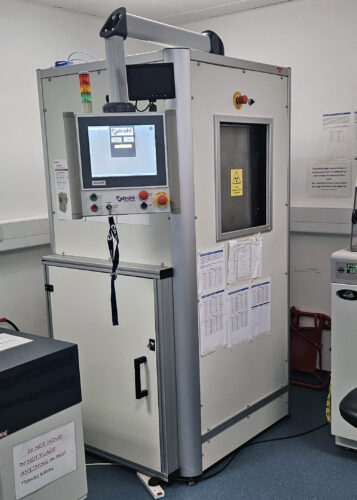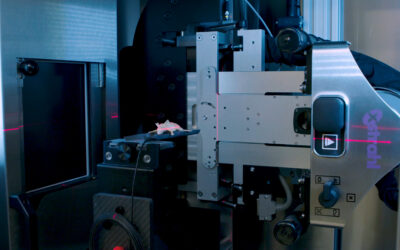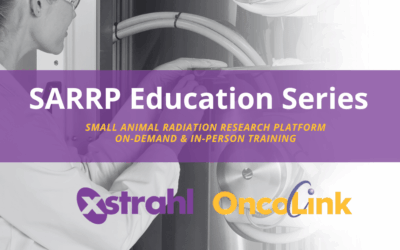
One of seven of Cancer Research UK’s (CRUK) Centres of Excellence in Radiotherapy Research, the CRUK RadNet Centre Glasgow includes three core laboratory teams of radiation researchers who work within the RadNet initiative to incentivize and encourage other cancer scientists to incorporate radiotherapy questions into their research. Over the five years of the CRUK RadNet initiative, a translational research community has emerged within the School of Cancer Sciences at the University of Glasgow and the CRUK Scotland Institute, formerly known as the CRUK Beatson Institute, within which there are multiple users of Xstrahl’s CIX2 cabinet for in vitro radiation studies. The research programme also benefits from the Small Animal Radiation Research Platform (SARRP) from Xstrahl for in vivo studies.

Prof. Anthony Chalmers, Director of the CRUK RadNet Centre Glasgow, and Katrina Stevenson, Senior Radiation Technician, oversee and facilitate much of the laboratory radiation research programme. The Glasgow team focuses on cancers that are treated with radiotherapy, but currently have poor outcomes, with particular interest in glioblastoma, pancreatic cancer, lung cancer, mesothelioma, head and neck cancer, locally advanced rectal cancer and hepatocellular carcinoma. Xstrahl spoke to them about their radiation research programme.
“We now have seven other groups who regularly use the CIX2 for in vitro radiation studies, and these are people who have never previously done any radiotherapy work.”
“One of RadNet’s aims is to incentivize and encourage people working in cancer research to start incorporating radiotherapy questions into their research programmes, and that is where Glasgow has been particularly effective and successful,” stated Prof. Chalmers. “We now have seven other groups who regularly use the CIX2 for in vitro radiation studies, and these are people who have never previously done any radiotherapy work.”

The CIX2 self-contained cabinet irradiator used for in vitro studies
The Xstrahl CIX2 fulfills the requirements of in vitro biological research, incorporating the irradiation chamber and system electronics in one enclosure. The intuitive and easy-to-use software interface enables programmable and automatic execution of dose delivery. At CRUK Glasgow, the CIX2 has been used daily by different groups since 2011, with researchers finding it to be user friendly and straightforward to operate.
“The CIX2 is really nice in that you switch it on and it irradiates exactly how you want it to do, and then it is done at the end of it.”
According to Katrina Stevenson, Senior Radiation Technician at CRUK Glasgow, “Before the CIX2, our earlier system used a cobalt source that required you to calculate the time that you would irradiate,” she explained. “But the CIX2 is really nice in that you switch it on and it irradiates exactly how you want it to do, and then it is done at the end of it. One of our lab technicians is responsible for training new people that come up and she’ll give them an overview of how it works. We are always available if people need a hand but usually it doesn’t take them very long to become familiar with how it works for their research.”
“We have users that will give a high dose to their cells as a one-off treatment and then it takes one hour to do one plate,” Stevenson continued. “And then we have other users that come in with a number of plates and they will just want to do shorter radiations and then they could use it for a couple of hours at a time, depending on the dose.”
There are at least 20 users on a consistent basis, with multiple users from each core group. There are some groups that use it weekly, but it is used daily by different people – running consistently for several hours on most days.
“The CIX2 has been a solid workhorse for RadNet.”
Stevenson added, “The CIX2 has been a solid workhorse for RadNet. Standard use of the CIX2 for an experiment may include high use for a week or two, or a bit longer, and then they may go a few weeks without using it and then they will come back and there will be another burst of activity. That’s just the nature of the experiments. We do masses of in vitro irradiations in the CIX2.”
SARRP used for in vivo studies
In addition to using the CIX2 cabinet irradiator, CRUK Glasgow also uses the Small Animal Radiation Research Platform (SARRP) for in vivo studies. Their first SARRP was first installed in 2012 and while this remains in place in another part of the campus, in 2019 they installed a second SARRP in a new building next door to the Wolfson Wohl Cancer Research Centre, which has been very convenient for the numerous in vivo experiments conducted by different members of the team.
Xstrahl gathers preclinical radiation researchers for an annual SARRP User Meeting. Stevenson had the opportunity to attend one in Philadelphia, PA in 2023. “It is a lovely community to be a part of and it’s nice going to something where people understand what you are talking about, and what you are doing,” Stevenson said. “I really enjoy it and it’s nice to meet up with the same people over and over and see how their work is developing over time. Xstrahl is very good at championing people as well and it is very enjoyable.”
Xstrahl is a valued partner
According to Prof. Chalmers, his group’s decision to partner with Xstrahl was uncomplicated. “It was quite straightforward,” he said. “For me and the team, it was the customer service and engagement from the Xstrahl people, and also the way the company works with the wider scientific community. Xstrahl views itself as a key part of that community, whereas other suppliers consider themselves a company with a product to sell.
Chalmers added “Amanda [Amanda Tulk, Xstrahl’s Chief Science Officer] has always been very keen to work with existing or prospective customers to find out what they are interested in and what challenges they are encountering and how Xstrahl can help them surmount these problems in a really collaborative way.”
About Cancer Research UK
 Cancer Research UK (CRUK) is the world’s largest independent cancer charity, dedicated to saving lives through research, influence and information. CRUK supports research into all aspects of cancer through the work of over 4,000 scientists, doctors and nurse. This pioneering work into the prevention, diagnosis and treatment of cancer has helped save millions of lives. In 2019, CRUK initiated its first funding scheme dedicated to radiotherapy research and awarded funds to seven centers of excellence around the UK, among them CRUK RadNet Glasgow.
Cancer Research UK (CRUK) is the world’s largest independent cancer charity, dedicated to saving lives through research, influence and information. CRUK supports research into all aspects of cancer through the work of over 4,000 scientists, doctors and nurse. This pioneering work into the prevention, diagnosis and treatment of cancer has helped save millions of lives. In 2019, CRUK initiated its first funding scheme dedicated to radiotherapy research and awarded funds to seven centers of excellence around the UK, among them CRUK RadNet Glasgow.







